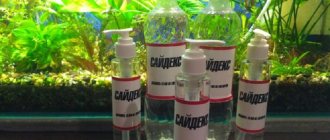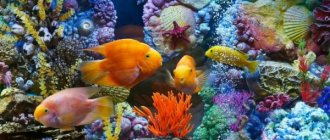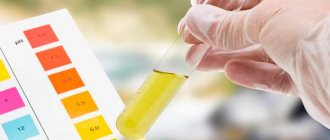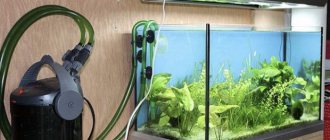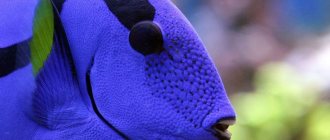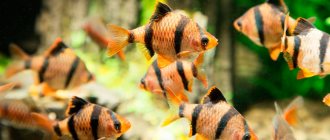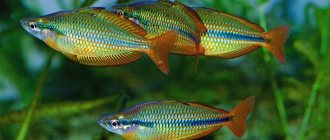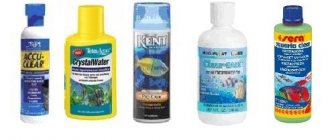The coil snail is a frequent visitor to aquariums. Some people get them intentionally, but more often these small aquarium mollusks appear by accident - small snails or their eggs can be brought in with the plants. The reel seems to be a very ambiguous inhabitant of the aquarium and has a number of both positive and negative qualities.
Horny
Description
The snail is a representative of freshwater mollusks. In nature, they live in overgrown reservoirs with weak currents. It is adapted to survive even in very dirty bodies of water with low oxygen content in the water. This ability is due to the presence of a kind of lungs that allow her to breathe atmospheric air.
The snail's shell resembles a flat, tightly wound spiral. There are usually four to five whorls, with each subsequent whorl thickening. The seam between the turns is clearly visible on both sides. The mollusk can reach sizes up to 3.5 centimeters in diameter, but most often in an aquarium, coils grow only up to 1 centimeter. By the way, the larger the snail population, the smaller they will be.
The body color can vary from brown to bright red, depending on the type of coil. The mollusk moves with the help of a leg with a wide flat base-sole. Thin long horns are visible on the head.
The snail can also move along the surface of the water, turning its shell down - this ability occurs due to the air bubble that is located in the shell. In case of danger, she immediately releases this bubble and falls to the bottom. Newborn small snails usually stick together, clinging to aquarium plants.
Return to content
Horny Red
Habitat in nature
Planorbidae, the common name for various species of coilfish, are a family of freshwater snails, air-breathing, aquatic gastropods. Unlike most shellfish, coil blood contains iron-based hemoglobin instead of copper-based hemocyanin. As a result, Planorbidae are able to breathe oxygen more efficiently than other molluscs. The presence of hemoglobin gives the body a reddish color. This is especially noticeable in albinos.
Being air-breathing, Planorbidae do not have gills but instead have lungs. The leg and head of Planorbidae are quite small, while their thread-like tentacles are relatively long. Many species of this family have spiral shells, which are more or less spiral flat rather than having a raised spire as is the case in most gastropod shells.
Kinds
- Horn coil. In nature, it lives in stagnant bodies of water with dense thickets of plants. The color of the shell is brown, the size is up to 3.5 centimeters. The body is colored reddish-brown, matching the shell. The horned coil prefers to feed on leftover food and plants from the bottom of the aquarium.
- Reel Horny Red. The size of this snail is smaller, up to 2 centimeters. It also differs from the usual horn coil in the bright red color of its shell. The benefit of the red horn coil is that it is an excellent aquarium cleaner. From a decorative point of view, this type is the most advantageous - their fiery color looks great against the background of greenery.
- Far Eastern reel. The Far Eastern reel came to us from the reservoirs of East Asia. Just like her relatives, she is unpretentious. The color of the shell is red-brown, the number of curls is from five to six. The diameter is small - only 1 centimeter. The Far Eastern coil feeds on plants.
- Keeled coil. This is the most frequent guest in aquariums. It gets into them with plants or soil. Color: grayish-brown. The main feature of the keel reel is that the diameter of the shell is much larger than the width: with 6-7 revolutions and a diameter of 2 centimeters, it is only 4 millimeters wide. This snail collects food at the bottom and also enjoys eating algae while cleaning the aquarium walls.
- Coil Wrapped. This type of coil is called a pest: it multiplies extremely actively, filling the entire aquarium in the shortest possible time and harming both the appearance and the condition of the water and soil. It reaches sizes up to 1 centimeter. The color of the shell is dirty yellow, the shell is not very strong.
Return to content
Far Eastern
Why are they useful?
Despite the fact that most often snails appear in an aquarium by accident, some aquarists deliberately leave them, believing that the benefits of them outweigh the harm.
The decorative function of these snails is undeniable. Reels are pretty cool aquarium decorations. They are fun to watch and their presence in a fish tank creates a more natural appearance.
It happens that coils, like other snails, are called aquarium orderlies. This is partly true. Coil snails eat rotten algae leaves without touching healthy ones. They collect the remains of fallen food, thereby ridding the aquarium of debris. The coils are also capable of removing film from the surface of the water and cleaning the aquarium walls.
Snails become an indicator of water pollution, suggesting that it is time to clean up or reduce the amount of fish food. If the population of coils has grown noticeably, this is a signal.
Some aquarists raise reels in their aquariums as fish food. Many fish enjoy shellfish, and the fertility of this species makes it easy to maintain numbers.
Return to content
Answers to frequently asked questions about coil snails
Do I need to get rid of snails?
There is an opinion that snails in an aquarium need to be destroyed. To do this, they release special fish that feed on such creatures; add special chemical additives to the water; destroying the coils chemically, or temporarily freeing the aquarium from fish and passing a weak electric current through the water. Is this necessary? Everyone decides for themselves. One thing is obvious: there is no harm from them, and the fact of transfer of infection into the aquarium world can be prevented by increased surveillance.
If there are only snails in the aquarium, what are the features of their feeding?
Feeding snails is not difficult. They are accustomed to eating any type of food, including those intended for fish. They eat dry food with pleasure. They love plant foods: zucchini, cucumber, cabbage, spinach, lettuce. Vegetables need to be washed, chopped in any way and it is better to pour boiling water over them - snails’ teeth are not sufficiently developed, so they do not like solid food. They eat a lot and for a long time. If there is an excess of food, snails can pollute the soil with their excrement.
Do they harm the plants in the aquarium?
Preferring plant foods, coils can often be seen on plant leaves. This has given many novice aquarists reason to believe that they are pests for vegetation. However, such views are misconceptions. In this matter, the coils act as orderlies of the aquarium. The subject of their interest is rotten, softened leaves, some that have fallen off, and some where blades of grass and twigs have been bitten off by fish. By feeding on them, the snail prevents the beginning of decay of vegetation, which cleanses the water house and brings benefits.
Coil snails are kind and harmless creatures. In the aquarium world, they occupy their niche and lead a calm, balanced lifestyle. If they seem redundant to you, start regulating their numbers. But the world of snails has its own patterns: they can disappear and sometimes appear without outside participation.
Post Views: 4,775
Why are they harmful?
Despite the fact that the benefits of snails are quite great, many people prefer to get rid of the mollusks as soon as they discover the uninvited guest.
Coils are very prolific. They are hermaphrodites, and just a couple of snails are enough to get a whole school of mollusks. Rapid reproduction leads to an increase in the amount of their waste products, which cause harm and pollute the aquarium.
If the snails do not have enough food, they will start eating aquarium plants. And not for rotten leaves, but for healthy ones. Hungry coils will quickly destroy the plant.
The spool snail can cause fish illness. This often happens when a snail is brought into aquarium conditions from a local reservoir. In such a situation, the fish will have to be treated with special drugs, which the snails most likely will not tolerate.
In general, an overgrown flock of snails spoils the appearance of the aquarium, hanging in whole clusters on the walls and plants.
Return to content
Keeled
Rules of care
Since the coils are able to adapt to any conditions, they do not require special care. However, despite this, the optimal temperature range is from +22C to +28C. It is recommended to periodically add calcium to the water; its deficiency will be noticeable by the appearance of the shell. The aquarium must be closed, as the mollusks can crawl out of the water and die.
Sometimes it is difficult to understand whether a snail is alive or dead. To do this, they pull it out and evaluate the smell - the dead one smells of rot. Dead individuals must be removed immediately, as they cause water spoilage.
How to keep
The optimal water temperature for snails is 22-28 degrees. But in general they are quite tolerant of temperatures. Coils live for about two years, less often - up to four. Dead snails need to be removed as quickly as possible - they decompose extremely quickly, and this can spoil the water. The aquarium in which the coils live must be closed - they can easily crawl to the surface and fall out.
You can feed them with vegetables - lettuce, zucchini, cucumber - boiled in boiling water. But usually the spool snails are not specially fed - if the fish are sufficiently fed, the mollusks have enough food. They also eat rotten plant leaves.
Return to content
Content
Beginner aquarists can safely start reels - these gastropods do not require special knowledge about caring for themselves. This means that a sufficient amount of attention and time will be given to the accessories and beautiful fish that surround them.
Some snails have attractive shells, which makes them the most desirable among their relatives. However, in unsuitable conditions, the shell may lose color, become damaged, or become overgrown with a white coating. This often happens because the owner stops paying attention to the mollusks’ diet, thinking that they get enough food by absorbing waste from the bottom of the container. To preserve its beauty and integrity, you need to add to the snail food products containing large amounts of calcium (white cabbage) and special calcium supplements . The average level of hardness of the aquarium water is also important, as well as a temperature of at least 22 and no more than 28 degrees.
Snails flee when there is a sudden change in their usual environment.
Tropical (but non-predatory) fish will be good neighbors for these sessile-eyed fish. If the snail dies, it should be caught as quickly as possible so that the remains do not spoil the water as they decompose in the aquarium. The aquarium must be closed (but not completely, leaving 10 cm) so that the mollusks do not crawl out.
Reproduction
It was already mentioned above that snails are hermaphrodites, and their reproduction rate is very high. One or two snails can create an entire population. At the same time, controlling the number of snails is quite simple, especially if the aquarium contains fish that eat shellfish.
The coil caviar looks like a thick transparent film with dots inside. It is usually deposited on the lower surface of a plant leaf, aquarium walls or rocks. This film is very dense, which prevents other inhabitants from damaging or eating the caviar. After about 2-3 weeks, the eggs of the reel hatch, and tiny snails appear in the aquarium.
Return to content
Wrapped
How to get rid
If a snail that accidentally gets into the aquarium does not cause delight, it can be removed. There are several ways: some only allow you to reduce the number, others - completely get rid of them.
- Adding ancitrus fish to the aquarium. They are excellent cleaners of glass and plant surfaces, and they are the only ones capable of cleaning off coil eggs. Thus, reproduction and population growth will stop. To speed up the process, the aquarium is also stocked with fish that feed on shellfish. Macropods, tetraodons - they will happily take on snails. But not everyone can add these fish. If the fish in the aquarium are incompatible with these species, they may suffer and die.
- There is also a type of shrimp called Macrobrachium that loves to eat snails, so it is often used to get rid of shellfish. But shrimp can also threaten slow-moving fish, so you need to be careful with it. You can fight the coils, oddly enough, with the help of another mollusk - the predatory Helena snail, which preys on all the small mollusks in the aquarium.
- Remove snails by hand. To do this, bait is placed in the aquarium: a leaf of lettuce or cabbage, scalded with boiling water, or a blackened banana peel. The coils will not be able to resist such a treat and will soon surround it completely. The bait with snails is carefully removed from the aquarium. This scheme needs to be done several times.
- Chemical exposure. There are a number of medications that can be purchased at a pet store. This method requires great caution - some substances included in the product can harm not only mollusks, but also other inhabitants of the aquarium. Usually, when using chemicals, the fish are resettled, but the established biobalance will be disrupted in any case.
- The most radical way is to completely flush the entire aquarium: plants, containers, decorative elements, and boil the soil. This method is very labor-intensive and time-consuming, but it allows you to get rid of snails completely.
Snails are not the most common inhabitants of the aquarium world. As you can see, they can be equally useful and extremely harmful. But with careful attention and proper control, the coils will not become a problem for your aquarium.
Return to content
Nutrition
These organisms for the most part prefer a plant-based diet. In the natural environment, they are fed by precisely those representatives of the flora on which they have settled down to live. And this is of course very convenient. Having a huge number of microscopic teeth, the coils, like a grater, scrape off plants piece by piece and absorb them.
While in the aquarium, they especially like to feast on small algae, gradually removing their green coating, raking it up with their “grater”, like a shovel. It is extremely interesting to observe this process through aquarium glass.
These creatures also show interest in animal food. For example, in captivity they can be fed raw meat, and they eat it very willingly. Although such snails have enough pasture in an artificial environment.
They consume dead fry, small invertebrates, remains of fish food, and rotting algae. But if you wish, you can pamper them with herbs, salad, vegetables, for example, cucumbers or zucchini.
